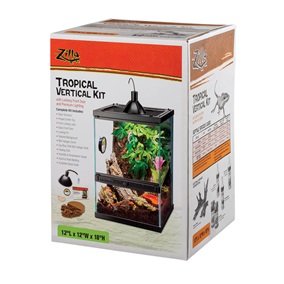Frog & Amphibian Facts
Amphibians are cold blooded vertebrates of the class Amphibia. The class Amphibia is comprised of three orders, containing five types of amphibians.
Anura - consists of frogs and toads
Caudata - consists of salamanders and newts
Gymnophiona - comprises the caecilians.
Amphibian means living in both land and water. Nearly all amphibians start their life in a larval aquatic stage after hatching from an egg. From there they grow limbs and morph into their adult or terrestrial stage.
Getting Started With Pet Frogs and Amphibians
Many amphibians breathe through their skin and must stay moist in order to do that. Their habitat must be able to hold 65-95% humidity, while still having some air flow. They can also be secretive, so plenty of areas to hide are important for them to feel safe.
Zilla Terrarium Moss is excellent for natural moisture retention and is ideal for building a comfortable amphibian terrarium. Other fitting substrates to use that will retain moisture and humidity are Zilla Jungle Mix or Zilla Coconut Husk Brick. You can begin building your terrarium by visiting our glass terrariums, tanks, and cages page.
Due to their permeable skin in is important to wash your hands thoroughly, a surplus of oils or lotions could pass through their skin and do them harm.
Housing and Habitat
As with all pets, it is important to research the natural habitat of the frog or amphibian you wish to care for and try to mimic it in captivity. Most frogs and amphibians come from tropical environments. Some live near ponds and bodies of water, some live on the rainforest floor, and others live up in trees. Creating a habitat that best reflects their natural environment is important to your frog or amphibians health and happiness. It is important to note that humidity is especially imperative to amphibians and their health, and adding moss to a terrarium can help to raise and maintain higher humidity. Starting with the proper enclosure is important and it should be tall for arboreal species or have a large water area for pond dwelling species. Water quality is important, so a high quality filter is necessary in any large water areas in a terrarium. The substrate should be non-toxic and be able to hold humidity. Consult the Zilla Bedding Guide for the best substrate choice for your pet frog oramphibian.
Frogs Require:
- Heat and light source to stay warm as well as cool areas in their tanks so they can self-regulate their temperatures. Be careful when choosing a heat light, as many amphibians may not need it.
- High humidity and access to clean water. This is important for the health of their skin.
- Decorations that mimic their natural habitats and provide cover.
What Do Frogs Eat?
How To Safely Handle Your Pet Frog or Amphibian
All amphibians lack scales and have permeable skin that allows them to absorb moisture and oxygen. Make sure to only handle them with clean moist hands, as they can absorb chemicals from your hands right into their body, and keep handling to a minimum to keep them from becoming stressed.
Always wash your hands after handling any reptile!
Should I Get a Frog or Amphibian as a Pet?
Frogs and other amphibians make interesting and beautiful pets, but doing your research before hand is essential. Many species of frogs don’t tolerate handling and it can also cause them health issues so if you want a pet you can "play" with consider that before getting your pet. Frogs and amphibians also need higher humidity than most animals, so daily misting and tracking of moisture is important and pet owners have to maintain this regimen. These animals do very well in planted and live vivariums which can be incredible to watch and enjoy!
Types of Frogs That Make Great Pets
African Clawed Frog African Dwarf Frog Amazon Milk FrogAmerican Green Treefrog
Budgett’s Frog
Cuban Treefrog
Dart Frog
Horned Frog
Painted Frog
Pixie Frog
Red Eyed Treefrog
Tomato Frog
Mantella Frog
Types of Amphibians That Make Great Pets
AxolotlRibbed Newt
Tiger Salamander
Select a Frogs & Amphibians Care Sheet to Download Care Sheets
Getting Started:
Tropical Vertical Kit
Zilla® Vertical Tropical Kit provides ample heat and lighting - the ideal environment for small tropical reptiles and amphibians such as tree frogs, crested geckos and more. Simply add Decor and climbing surfaces to complete the overall environment.


